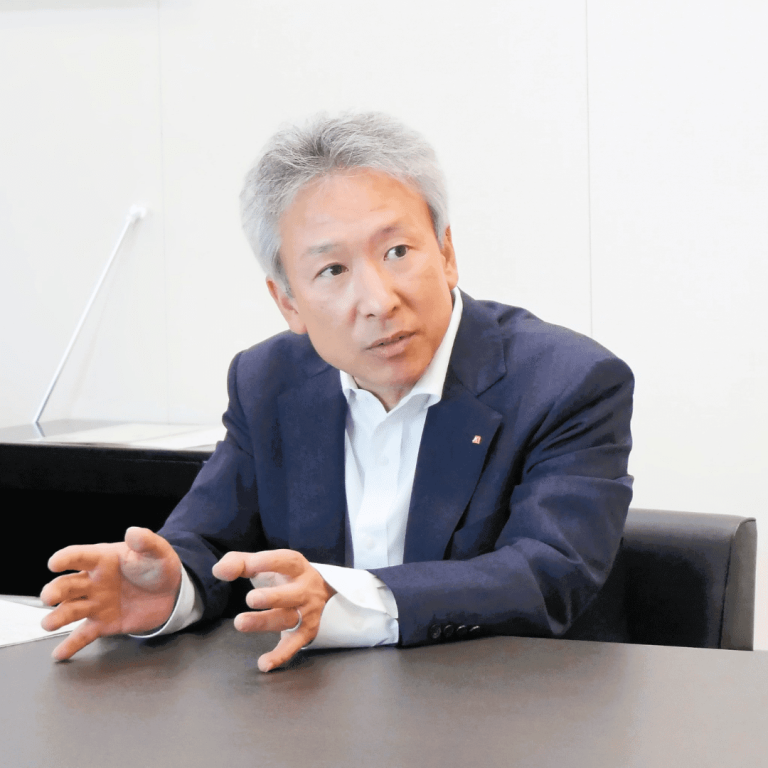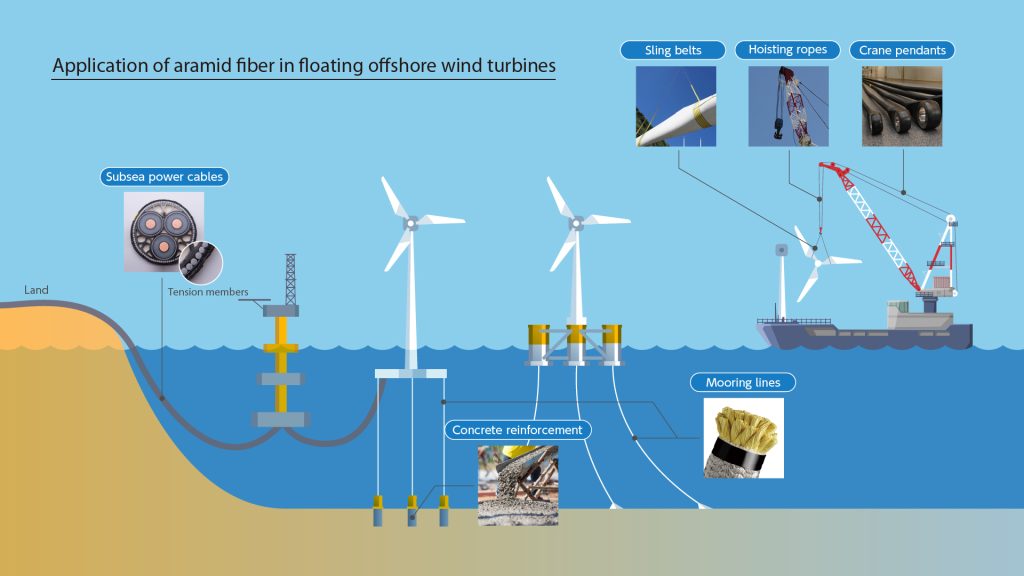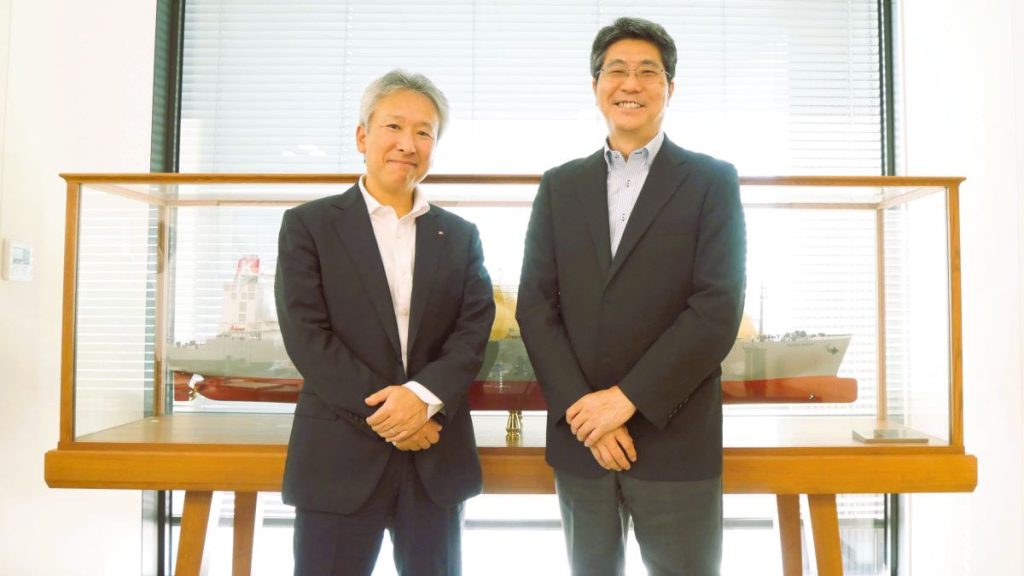

2022/11/02

Japan has committed itself to achieving zero greenhouse gas emissions by 2050. This commitment compels many Japanese companies to prioritize decarbonization as a vital management issue alongside business efficiency, product quality and value creation.
Major shipping company Kawasaki Kisen Kaisha, Ltd. (“K” LINE), for example, aims to support the decarbonization of society by eliminating its 6.6 million tons of annual CO₂ emissions by 2050. In this article, we explore “K” LINE’s decarbonization efforts, including its cross-industry collaboration with Teijin, which possesses textile technology useful for decarbonization.

Satoshi Kanamori / Executive Officer in charge of LNG, Carbon-Neutral Promotion, Kawasaki Kisen Kaisha, Ltd. (“K” LINE)
Renewable energy is indispensable for achieving carbon neutrality. But the most appropriate type of renewable energy for each country varies depending on its climate and terrain. For example, solar power is probably not ideal for Japan, where rain is frequent and the land is largely mountainous. “Offshore wind power generation holds huge potential for Japan, which is surrounded by the sea and possesses the world’s sixth largest exclusive economic zone (EEZ),” says Satoshi Kanamori, Executive Officer in charge of promoting carbon neutrality and LNG at “K” LINE. “The knowledge “K” LINE has gained by supporting the installation and operation of offshore oil and gas plants will be useful in this area.”
On June 1, 2021, the “K” LINE Group established “K” Line Wind Service, Ltd (KWS) to engage in business related to offshore wind power generation. The new company surveys and develops wind turbine installation sites, transports wind turbine components and building materials, constructs and installs wind turbines, handles operation and maintenance tasks such as the transport of maintenance personnel, and more.
“Why does Japan lag behind Europe in offshore wind power generation efforts?” asks Tadashi Sakata, Executive Officer of Teijin Group and General Manager of New Materials Business Division. Kanamori explains, “Europe is extremely eco conscious and took the lead in offshore wind power generation. But it mainly uses “bottom-fixed offshore wind turbines” with bases embedded in the seabed because the territorial waters are shallow with wide seabed. Japan, on the other hand, is largely surrounded by deep seas more appropriate for “floating offshore wind turbines” that place power generation equipment on floating structures. These tend to be more costly than bottom-fixed offshore wind turbines and the legal framework for their installation and operation has not been established. We are still preparing for actual implementation.” Companies which are capable to develop floating offshore wind turbines are growing “K” LINE is preparing to offer a mooring anchor installation service that fixes floating offshore wind turbines within a certain area. However, some issues must be resolved before floating offshore wind turbines go mainstream. “Current floating structures are so heavy, and transportation and installation requires a lot of time and money. We would like to see mooring lines made of synthetic fiber.” Kanamori suggests.
Sakata recommends Teijin’s aramid fiber. “We’ve already had success using it to reinforce pipelines for flowlines that transport oil and gas from offshore oil fields. It improves work efficiency during installation because it’s lighter and more flexible than steel. It’s also rustproofed and highly durable, which makes it suitable for offshore plants. Moreover, mechanical properties, durability and braiding method can be adjusted for use in mooring lines for large vessels and subsea power cables. Furthermore, sling belts, hoisting ropes and crane pendants made of aramid fiber can contribute to more efficient installation of wind turbines” (Fig. 1)

Figure 1: Application of aramid fiber in floating offshore wind turbines (including examples still in the evaluation phase) / Source: Teijin
Most shipping companies fuel their vessels with heavy oil that emits CO₂. Fuel-cell powered vessels are cleaner, but incapable of carrying large amounts of cargo on long voyages. So “K” LINE is exploring various alternatives in its efforts to decarbonize.
One promising effort is the eye-catching “Seawing”, a large automated kite system that uses wind power for supporting propulsion (Fig. 2). “K” LINE has been collaborating with Airseas, a spinoff from French company Airbus, to jointly develop and install this system on its ships. The system continuously collects and analyzes weather and oceanographic data in real time, automatically deploys and stows away when appropriate, and effectively maximizes wind propulsion while ensuring safety. “With this technology we expect to reduce CO₂ emissions by 20% or more on any kind of ship including our existing ones,” claims Kanamori. By the end of 2022, the company plans to complete installing the system on its large bulk carrier.

Figure 2: Seawing automated kite system used by “K” LINE / Source: “K” LINE

Tadashi Sakata / Executive Officer of Teijin Group, General Manager of New Materials, Business Division, Teijin Limited
“K” LINE is already introducing LNG-powered vessels that emit around 25-30% less CO₂ than conventional vessels powered by heavy oil. The company plans to introduce around 40 LNG-powered vessels by 2030 and also consider vessels that use hydrogen or ammonia as fuel, which emit zero CO₂ during operation. Engines powered by these fuels will be developed by engine manufacturers, but “K” LINE is studying/working how to develop supply chain such as transporting, stockpiling, and supplying such fuel with partners. Kanamori thinks ammonia will become a practical fuel soon and expects ships equipped with ammonia-powered engines to emerge in the latter half of the 2020s.
While both hydrogen and ammonia include dangerous substances, ammonia may be easier to use in society because a transportation infrastructure and legal framework for its safe handling have already been established. On the other hand, ammonia production is difficult to decarbonize.
Sakata explains the problem and a possible solution. “Ammonia is currently produced by the Haber–Bosch process, which requires large amounts of energy. The energy requirements make it difficult to reduce CO₂ emissions in the lifecycle of the fuel. But a process is now being developed that uses a new catalyst material to produce ammonia at low temperature and low pressure. Teijin is involved in development of this process and hopes it will contribute to a practical, low energy solution.”
Recycling is an important part of decarbonization and will contribute to sustainable use of the oceans as called for by the SDGs.
“The shipping industry has a risk to pollute oceans through maritime accidents, oil leaks and so on. But “K” LINE wants to help keep our oceans clean,” Kanamori assures us. “We operate about 430 ships around the world. Ships take in seawater to control their balance as ballast water. Taking such an opportunity, we are jointly working with industry-academia to collect data on the state of pollution by filtering and collecting samples of seawater from each sea area for research purpose.”
Teijin is trying to reduce plastic waste in the oceans by increasing the recycling of fishing nets. “30 to 40 percent of plastic in the oceans comes from damaged fishing nets that are dumped in the water because industrial waste disposal is expensive,” Sakata informs us. “While recycling has begun for fishing nets made of nylon (the most common net material), a recycling process for fishing nets made of polyester (the second most common net material) has not been developed yet. So Teijin is trying to establish a practical recycling process for polyester fishing nets,” Sakata says.
The most challenging part of recycling polyester fishing nets is removing salt, sand, shells and other deposits and surface coatings from the nets. Teijin overcame this challenge by establishing a process that effectively combines washing by detergents and dry cleaning by solvents. The resulting recycled resin is used to make buckets, dishes and other objects that are sold with an eco mark stating “made by recycling marine plastic waste and fishery plastic waste.” Sakata adds, “Recycled plastics are expensive now, but cost benefits will emerge if carbon taxes are introduced because these plastics reduce CO₂ emissions during production.”
Both decarbonization and recycling are essential to run a sustainable business. Kanamori confesses, “The world is moving so fast that it has become difficult for single companies to meet new demands on their own.” Sakata agrees, “Although technological development is crucial in the synthetic fiber industry, we can’t meet changing needs by simply creating proprietary technologies.” Instead, new innovations are being created through collaborations between players in different industries, such as Teijin’s use of aramid fiber to evolve the coming offshore wind power services of shipping company “K” LINE.

Company name:Kawasaki Kisen Kaisha, Ltd. (“K” LINE)
Location:2-1-1 Uchisaiwai-cho, Chiyoda-ku, Tokyo (Iino Building)
Company website:https://www.kline.co.jp/en/
Company name:Teijin Limited
Location:Kasumigaseki Common Gate West Hall, 2-1 Kasumigaseki 3-chome, Chiyoda-ku, Tokyo
Company website:https://www.teijin.com/